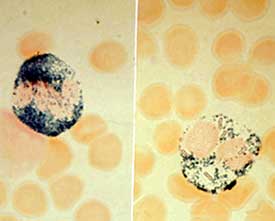 |
|||||||||
|
Research Feature Stories: Other News: |
Klebanoff Noted for Discovering Key Defense Mechanism
Medical investigators all over the world who have worked on a critically important bright green enzyme in the blood called myeloperoxidase have based their research on the earlier groundbreaking work of Dr. Seymour Klebanoff, UW professor of medicine. Myeloperoxidase, to a considerable degree, is responsible for killing a number of invading bacteria and other infectious organisms. Klebanoff first described this key mechanism of the body’s immune system in a paper published in 1967 in The Journal of Experimental Medicine.
|
Dr. Seymour Klebanoff, shown in his office lab, conducted seminal work on how the body fights harmful bacteria. Klebanoff's work has led him to be considered by many as the father of myeloperoxidase studies. |
 |
According to his colleague, Dr. Henry Rosen, professor and associate chair of the Department of Medicine, Klebanoff’s work was seminal.
“He put myeloperoxidase on the map with a function,” Rosen said. “I think many consider Klebanoff to be the father of the field.”
The process begins when a type of white blood cell called the neutrophil (or phagocyte) senses microbial invasion, migrates to the site, and adheres to and ingests the microbe, by sequestering it in an intracellular sac called a phagosome. During this envelopment, the phagocytes consume a large amount of oxygen in a “respiratory burst.” The oxygen is converted to hydrogen peroxide. Myeloperoxidase, a key ingredient of the granules present in neutrophils, is released along with an arsenal of other toxic agents into the phagosome containing the ingested bacteria. The accumulation of neutrophils forms pus, which gets its green color from myeloperoxidase.
|
These micrographs show how a white blood cell moves toward a bacterium (left photo) and sequesters it in an intracellular sac (right photo). |
 |
At that point the myeloperoxidase interacts with the hydrogen peroxide and chloride in the phagosome to produce hypochlorous acid, which is lethal to the invading bacteria. Hypochlorous acid is the active ingredient in common household bleach, which, of course, also kills bacteria.
“It’s as if the phagocytes attract bacteria into an intracellular swimming pool and then turn on a spigot of Clorox to kill them,” said Klebanoff.
Some infants are born with a genetic defect that impairs the respiratory burst of their neutrophils and thus their ability to fight bacteria. Such children have a short life expectancy. Klebanoff and others have had some success using gamma interferon to activate these children’s phagocytes.
 |
Klebanoff, shown at his microscope, has been widely recognized for his research, including receiving the Bristol-Myers Squibb Award for Distinguished Achievement in Infectious Disease Research. |
Some of his recent work has demonstrated that hydrogen peroxide formed by bacteria called lactobacilli, the predominant bacterial species found in the vagina of normal women, can kill the HIV virus, particularly when combined with myeloperoxidase. The problem, said Klebanoff, is that the hydrogen peroxide can also activate the part of the AIDS virus that functions as an on-off switch for viral replication. These bacteria are of considerable research interest, not just in relation to heterosexual AIDS transmission, but also to other sexually transmitted diseases.
Klebanoff and his colleagues have also discovered that phagocytosis, which is a key bodily defense weapon, can at times damage normal tissue, such as the kidneys, by releasing toxic agents outside of the cell.
Klebanoff has been widely recognized for his groundbreaking research. He is a recipient of the prestigious Bristol-Myers Squibb Award for Distinguished Achievement in Infectious Disease Research, a fellow of the American Academy of Arts and Sciences, and a member of the National Academy of Sciences and Institute of Medicine.
|
| UW AMC Medical Center | UW School of Medicine | Harborview | UW MC | Search UW AMC | UW Home | Contact Us | ©2001-2002, University of Washington Academic Medical Center. All rights reserved. Please honor our copyrights. |
|